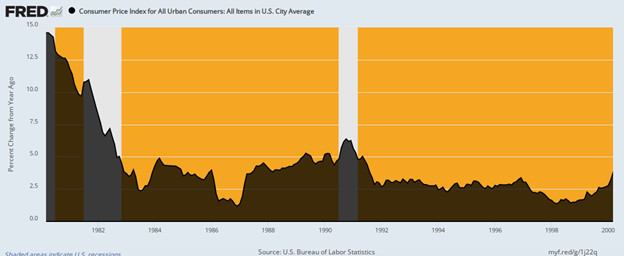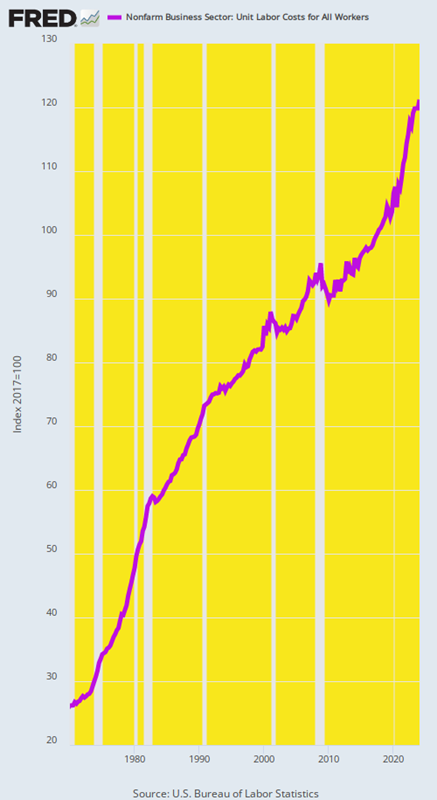David Stockman's Contra Corner
June 15, 2024
The reason for the dangerously high growth rates of Fed credit is what might be termed the inflation confirmation fallacy. That is to say, once high inflation broke out for the first time in peacetime history, flummoxed mainstream economists soon embraced the notion that the central bank should midwife a gentle, gradualist cure by "accommodating" some significant part of the rising price level, lest a too stingy growth of Fed credit would cause real interest rates to soar and bring the economy to its knees.
The effect of this unfortunate assumption was the introduction of inflation rate management into the Fed's remit, tool kit and vocabulary. While the official 2% "goal" did not materialize until decades later, it did creep into practice on a de facto basis under Volcker and his successors. At length, the idea that the Fed was not simply managing bank reserves and credit, but was in charge of the performance of the entire GDP including the rate of increase in the general price level became deeply embedded in the institution.
To be sure, Paul Volcker was exceedingly cautious on the matter of accommodating the embedded inflation and bringing down the rate of price increase in a deliberate manner, but he was also a sound money man at bottom. He was willing to accommodate existing inflation to only a limited degree and was ready to risk a recessionary contraction if that was required to break the back of financial speculation and the extant spiral of wage/price/cost inflation that had become embedded during the 1970s.
In fact, that's actually what did happen and the deep recession of 1981-1982 did accelerate the pace of disinflation. From the peak Y/Y rate of 14.6% in March 1980, the CPI increase slowed sharply to just 2.36% as of July 1983.
At that point, however, Volcker was reluctant to press the case back to old-fashioned notion of price stability, even as he was forced to cope with the Texas cowboy (i.e. James Baker) who had taken over the Treasury during Reagan's second term. The latter forced through the abomination of the 1985 Plaza Accord, a globally "coordinated" and/or imposed maneuver to trash the strong dollar, thereby importing inflationary pressures back into the US economy.
In any event, the Y/Y inflation rate bottomed at 1.91% in February 1987 and that very month Howard Baker became chief of staff at the White House. From that point forward the two Bakers-James and Howard, who were both easy money inflationists-operated a de facto GOP (the Republican Party) regency in the Reagan White House. So doing, they were not about to have the independent Volcker getting in the way of Republican electoral success.
So Paul Volcker was out, and his successor, Alan Greenspan, soon faced the infamous 22.6% stock market collapse on October 19, 1987. Thereupon, the once and former gold standard advocate and Ayn Rand disciple opened up the spigots at the Fed's money-pump, thereby initiating a new surge of inflationary pressure during the last years of the 1980s.
As is evident by the chart below, Volcker's partial victory over inflation was short-circuited after mid-1983. In all, the price level rose by71% or 3.3% per annum through the next stock-market meltdown, when the NASDAQ plunged by 33% during 30 trading days in March/April 2000.
Y/Y CPI Change, March 1980 to March 2000

Greenspanian "Wealth Effects"
This capitulation to permanent, residual inflation in the 2-4% zone was a huge historical mistake. It opened the way for Greenspanian "wealth effects" management and the resulting economic abominations. That is, a battered main street economy, which gave way to massive off-shoring of America's industry, coupled with the relentless inflation of financial assets, which showered Wall Street and the 1% with hideous amounts of unearned windfall wealth.
The trigger for this untoward breakdown was Greenspan's fundamental policy error. He invented the spurious argument that residual inflation at 2-3% was good enough, when the actual requirement was to purge the inflationary cost structure that was already embedded in the US economy owing to the inflation spree of the 1970s.
What resulted from the Greenspan pivot was nothing more than a great inflationary disaster which amounted to monetary central planning and pro-inflation targeting by the central bank. Suffice to remind why a huge share of America's merchandise goods are now sourced in China and other parts of the global low-wage supply chain. To wit, the Fed simply inflated American workers out of their jobs via soaring unit labor costs, which became increasingly noncompetitive in global markets.
U.S. Unit Labor Cost Growth, 1970 to 2024

Reprinted with permission from David Stockman's Contra Corner.